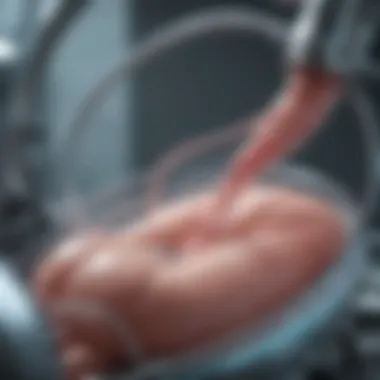Understanding Soft Chemotherapy: An In-depth Exploration


Intro
Soft chemotherapy represents a significant shift in cancer treatment methodologies. Traditional chemotherapy, characterized by its aggressive nature, often leads to a heavy toll on patients' bodies. In contrast, soft chemotherapy seeks to mitigate these adverse effects while maintaining efficacy. This section will lay the groundwork for a deeper understanding of the principles and mechanisms underlying soft chemotherapy, setting the stage for a thorough exploration of its implications in modern oncology.
Key Concepts and Terminology
Definition of Key Terms
Understanding the terminology is crucial in grasping the essence of soft chemotherapy. Below are some key terms:
- Soft Chemotherapy: A treatment approach that employs lower doses of chemotherapy drugs or alternative agents to reduce side effects while effectively targeting cancer cells.
- Cytotoxicity: The quality of being toxic to cells, which is a primary mechanism utilized in conventional chemotherapy.
- Targeted Therapy: A type of cancer treatment that uses drugs or other substances to precisely identify and attack cancer cells, sparing healthy cells.
Concepts Explored in the Article
- Mechanisms of Action: The article will discuss how soft chemotherapy works, focusing on the biological mechanisms involved in targeting cancer cells.
- Benefits: Various advantages of soft chemotherapy over traditional approaches will be analyzed, including improved quality of life and reduced side effects.
- Patient Outcomes: Examination of how soft chemotherapy impacts patient outcomes compared to conventional chemotherapy.
- Research Trends: The current landscape of research surrounding soft chemotherapy and its evolving applications will be covered.
Findings and Discussion
Main Findings
Emerging evidence highlights several key findings about soft chemotherapy:
- Patients experience fewer side effects, leading to better adherence to treatment regimens.
- Initial studies suggest comparable efficacy to traditional methods for specific cancers, although conclusive data is still developing.
- Enhanced patient comfort addresses both psychological and physical aspects of cancer treatment.
"Soft chemotherapy offers a more humane approach to cancer treatment, prioritizing quality of life alongside curative intent."
Potential Areas for Future Research
Several areas warrant further investigation to refine the understanding of soft chemotherapy:
- Identification of optimal dosage and combination therapies that maximize effectiveness while minimizing toxicity.
- Longitudinal studies to better assess long-term outcomes and survivorship issues.
- Exploration of patient-specific factors that may influence the success of soft chemotherapy treatments.
This exploration of key concepts and findings sets the stage for a more profound examination of soft chemotherapy in the following sections, emphasizing its role in contemporary cancer care.
What is Soft Chemotherapy
Soft chemotherapy represents an evolving paradigm in oncological treatment, prioritizing gentler methodologies while aiming for effective cancer management. This approach is increasingly significant in today's medical landscape, as it addresses the need for less invasive treatment options that mitigate the harsh side effects often associated with traditional chemotherapy. Understanding soft chemotherapy is crucial for medical professionals, researchers, and patients alike, as it opens doors to personalized treatment plans that enhance quality of life, particularly in populations that may not tolerate aggressive therapies.
Defining Soft Chemotherapy
Soft chemotherapy focuses on the administration of antineoplastic agents in a manner intended to minimize damage to healthy tissues while targeting malignant cells. This treatment employs a variety of methodologies that are tailored to the specific cancer type, patient condition, and overall health profile. Notably, the aim is to reduce toxicity and side effects, thus allowing patients to maintain a better quality of life during treatment.
Soft chemotherapy may include dose adjustments, the use of less potent drugs, or methods that enhance the delivery of drugs to the cancerous cells specifically. Techniques like localized therapy or the combination of chemotherapy with advanced strategies such as immunotherapy represent notable advancements in this area, promoting more refined and patient-centered care.
Historical Context
The evolution of soft chemotherapy can be traced back to the recognition of the severe limitations of traditional chemotherapy. Traditional methods, while effective at shrinking tumors, often result in significant collateral damage. Patients frequently experience debilitating side effects that hinder their daily lives and overall well-being. With the advent of more sophisticated understanding regarding cancer biology and drug delivery systems, the field has transitioned to exploring softer approaches.
Over the past few decades, research has progressively illuminated the need to balance efficacy with tolerability. Clinicians began investigating various methodologies, such as targeted therapies, that could directly attack cancer cells without major impacts on healthy cells. These advances have led to the development of protocols that allow physicians to modify treatment in real-time based on patient response, thereby enhancing the relevance and personal touch in oncological care.
Now, soft chemotherapy stands not only as a viable alternative, but as a critical evolution within oncology. This historical shift reflects a deeper comprehension of the complex interactions between cancer treatments and patient health, emphasizing the importance of continuous research and adaptation in therapeutic approaches.
Mechanisms of Soft Chemotherapy
The mechanisms of soft chemotherapy are crucial for understanding how this treatment approach operates within the realm of oncology. By focusing on less aggressive methodologies, soft chemotherapy presents a technique that aims to minimize collateral damage while maximizing therapeutic potential. This section will delve into the cellular targets and methodological approaches that define soft chemotherapy. The benefits, as well as the considerations related to these mechanisms, will be explored in detail as we unravel this advanced mode of cancer treatment.
Cellular Targets
Targeting specific cancer cells


Targeting specific cancer cells is a foundational aspect of soft chemotherapy. This mechanism concentrates on the unique characteristics of cancerous cells. By aiming therapies at these specific targets, soft chemotherapy can deliver potent treatments with reduced harm to healthy tissues. This specificity is beneficial because it enhances drug efficacy while limiting side effects.
A key characteristic of this approach is its ability to employ biomarker identification. By using biomarkers, oncologists can determine which cancer cells to target, ensuring a more personalized treatment plan. The unique feature of targeting cancerous cells revolves around the precision of treatment. However, there can be disadvantages, such as the potential for tumor heterogeneity, which can make this targeting less effective in some cases.
Impact on healthy cells
The impact on healthy cells is another significant factor in soft chemotherapy. Traditional chemotherapy often affects both cancerous and healthy cells, leading to harsh side effects. In contrast, soft chemotherapy strives to protect healthy cells while attacking malignancies. This selective action is valuable for maintaining patient quality of life during treatment.
A defining characteristic of this approach is its reduced toxicity. Since the treatment is designed to spare normal cells, patients experience fewer adverse reactions. On the other hand, a unique challenge is ensuring that the safety mechanism is foolproof. If healthy cells are inadvertently affected, it could reverse the benefits intended by this gentler method.
Methodological Approaches
Combination therapies
Combination therapies are integral to the success of soft chemotherapy. This technique involves using multiple agents synergistically to enhance overall effectiveness. By employing different mechanisms of action, combination therapies can tackle cancer more aggressively while still minimizing harm. The benefit of this approach lies in its potential to combat resistance mechanisms that tumors develop over time.
The distinct feature of combination therapies is their ability to leverage the strengths of various drugs. However, there are challenges, such as increased complexity in treatment regimens and potential for cumulative toxicity. Finding the right balance is crucial for optimizing patient outcomes in the context of this strategy.
Nanoparticle-induced drug delivery
Nanoparticle-induced drug delivery has emerged as a revolutionary method in soft chemotherapy. This technique enhances drug solubility and stability while allowing for targeted delivery to cancer cells. The importance of this approach lies in its ability to improve drug efficacy and reduce systemic toxicity.
A key characteristic is its capability to encapsulate drugs effectively. This enables a higher concentration at the tumor site while minimizing exposure to surrounding healthy tissues. Nonetheless, there are disadvantages, including the potential for immune response against nanoparticles and the complexity of the manufacturing process.
In summary, the mechanisms of soft chemotherapy leverage targeted therapies and innovative delivery methods to create more effective treatment options with reduced toxicity. Understanding these mechanisms is critical for enhancing patient experiences and outcomes.
Comparative Analysis: Traditional Versus Soft Chemotherapy
In the realm of oncology, choosing the right treatment strategy is essential for optimizing patient care and outcomes. The comparative analysis between traditional chemotherapy and soft chemotherapy is particularly important as it sheds light on their distinct methodologies, effectiveness, and tolerability. This section will delve into the efficacy considerations and side effects, helping to highlight why soft chemotherapy presents a favorable alternative for certain patient populations.
Efficacy considerations
Success rates
Success rates refer to the proportion of patients who respond positively to treatment, a critical metric in assessing the effectiveness of any cancer therapy. In traditional chemotherapy, success rates can vary significantly depending on cancer type and stage. For instance, some studies indicate that traditional chemotherapy can lead to high remission rates in certain cancers, such as leukemia or testicular cancer. However, it must be noted that soft chemotherapy aims to enhance the success rates by reducing the intensity of treatment while still achieving therapeutic effects.
The key characteristic of success rates in soft chemotherapy is its focus on targeted modalities, allowing for a more refined approach. This is particularly beneficial as it helps in minimizing damage to non-cancerous tissue, thus improving overall treatment outcomes. However, one downside is that success rates in soft chemotherapy may not always match those of traditional therapies, particularly in aggressive or advanced-stage cancers.
"The objective is not only to fight the cancer but to do so with a strategy that minimizes collateral damage."
Treatment durability
Treatment durability refers to the duration of time a treatment remains effective before cancer recurrence. In discussion of treatment durability, soft chemotherapy exhibits unique features. It often seeks to promote longer intervals between treatments, allowing patients to recover physically and emotionally, which can enhance their overall well-being. This approach can potentially prevent the rapid cycle of treatment and recovery seen in traditional methods.
The prominent advantage of soft chemotherapy in this context is its cumulative effect over time, where the gentler approach can lead to sustained responses in certain patients. Nevertheless, a challenge remains in establishing standardized protocols that measure treatment durability comprehensively. This can pose difficulties in comparing soft chemotherapy directly to traditional options, as metrics may be less defined.
Side Effects and Tolerability
Adverse reactions
Adverse reactions are a significant concern whenever cancer treatment is undertaken. In traditional chemotherapy, adverse reactions might range from severe nausea and fatigue to long-term complications like neuropathy. In contrast, soft chemotherapy aims to reduce the incidence and severity of these adverse reactions. This makes it an appealing choice for patients who are concerned about the harsh side effects associated with conventional methods.
A key characteristic here is that soft chemotherapy can often be tailored to the individual, allowing for modifications based on patient sensitivity. However, proponents of traditional chemotherapy sometimes argue that the strong adverse reactions could be indicative of more aggressive tumor control.
Quality of life assessments
Quality of life assessments evaluate how cancer treatment impacts the overall well-being of patients. This particular aspect often becomes a pivotal part of treatment discussions. Soft chemotherapy is designed to prioritize quality of life, often resulting in fewer disruptions to daily activities and social engagements.
Patients undergoing soft chemotherapy frequently report improved comfort and psychological outcomes, which is an important measurement in today's treatment landscape. However, a limitation with this approach is that some patients might perceive the gentler methods as less effective, leading to concerns regarding their treatment choices. More research is needed to quantify these assessments fully and their impact on long-term outcomes.


Patient Selection for Soft Chemotherapy
The selection of suitable patients for soft chemotherapy is fundamental to the efficacy of the treatment. Understanding the characteristics that define an ideal candidate is crucial. This selection process impacts not just treatment outcomes but also the overall patient experience. Proper patient selection can reduce the risk of adverse effects and improve the quality of life during treatment.
Identifying Suitable Candidates
Identifying suitable candidates for soft chemotherapy involves a thorough evaluation of medical history and current health status. Patients with specific cancer types, such as certain leukemias or lymphomas, may benefit more from this gentler treatment approach. Key factors to consider include:
- Cancer stage: Early-stage cancers often respond better to softer treatments.
- Patient's age and health: Older patients or those with comorbidities may not tolerate aggressive therapies.
- Previous treatments: Patients with a history of severe side effects from traditional chemotherapy might be better candidates for soft chemotherapy.
The idea is to assess a patient's individual circumstances to personalize treatment plans effectively. This tailored approach enhances the likelihood of favorable outcomes and proper management of resources.
Assessment Tools and Criteria
Several assessment tools and criteria are used to facilitate the patient selection process in soft chemotherapy. These tools aim to evaluate both physical and psychological aspects of the patient’s health. Common factors include:
- Performance status scales: Such as ECOG (Eastern Cooperative Oncology Group) can help assess a patient’s ability to perform daily activities.
- Biomarkers: Specific blood tests and genetic profiling can indicate which patients are more likely to respond positively to soft chemotherapy agents.
- Patient preferences: It’s essential to include patient wishes during the selection process, promoting adherence and satisfaction with treatment.
A structured assessment approach can help oncologists make informed decisions regarding which patients are best suited for soft chemotherapy. It also ensures that the treatment is aligned with the unique needs and preferences of each patient.
"Patient selection is not just about the disease; it’s about the individual."
Conclusively, effective patient selection for soft chemotherapy requires a multifaceted evaluation encompassing medical, psychological, and personal factors. This holistic approach is vital for optimizing treatment outcomes.
Administering Soft Chemotherapy
Administering soft chemotherapy is crucial for ensuring that patients receive tailored treatments that align with their specific needs. This approach emphasizes individualized care that strives to minimize toxicity while maximizing treatment efficacy. The benefits of administering soft chemotherapy include lower side effects, improved quality of life, and increased adherence to treatment regimens.
Dosage Determination
Standard protocols
Standard protocols in soft chemotherapy establish general guidelines for dosing and treatment duration. These protocols are based on extensive clinical research and evidence-based practices. The key characteristic of standard protocols is their aim to create a consistent method for administering chemotherapy agents safely and effectively. They are a beneficial choice because they facilitate the standardization of care across different treatment centers.
The unique feature of standard protocols lies in their reliance on population data to inform dosing. This can be advantageous as it allows healthcare providers to refer to established guidelines when planning treatment. However, it may also present disadvantages, as not all patients may respond identically to the same dosing schedule, highlighting the need for further customization.
Individualized treatment plans
Individualized treatment plans consider the unique characteristics of each patient, including their genetic profile, health status, and specific type of cancer. This approach contributes to optimizing treatment outcomes and minimizing adverse effects. The key characteristic of individualized treatment plans is their adaptation to the patient, which allows for more effective drug utilization compared to one-size-fits-all methods.
The unique aspect of individualized treatment plans is their emphasis on tailoring drug regimens to specific patient characteristics. This personalization can provide advantages such as enhanced efficacy and reduced treatment-related toxicity, promoting a better overall experience for patients. Nevertheless, creating these plans can be complex and may require extensive testing and ongoing adjustments as treatment progresses.
Administration Routes
Choosing appropriate administration routes for soft chemotherapy is essential in managing how drugs are delivered to patients. This aspect significantly influences the effectiveness and safety of treatments.
Intravenous methods
Intravenous methods involve administering chemotherapy drugs directly into the bloodstream through a vein. This route is significant as it ensures rapid drug distribution throughout the body, which can be critical for treating aggressive cancers. The key characteristic of intravenous methods is their ability to achieve high drug concentrations quickly, supporting effective treatment.
A unique feature of intravenous method is the potential for strict control over the dosing schedule, enabling adjustments based on patient response and tolerability. On the downside, it can require more time and medical supervision compared to other methods, leading to logistical challenges for some patients.
Oral options
Oral options for soft chemotherapy represent an alternative delivery system where patients take chemotherapy pills or liquid formulations at home. This approach plays a vital role in enhancing comfort and convenience for patients. The key characteristic of oral options is their ease of administration, which empowers patients to handle their treatments independently.
A particular advantage of oral options is the reduction of frequent hospital visits, which can significantly benefit patients who may find traveling to treatment centers challenging. Nonetheless, oral chemotherapy may have variable absorption rates, potentially affecting consistency in drug levels within the bloodstream, and necessitating careful management by healthcare providers.
Recent Advances and Research in Soft Chemotherapy


Recent advances in soft chemotherapy are central to understanding how modern cancer care is evolving. This section delves into innovative treatment modalities that are reshaping the landscape of oncology. The integration of advanced techniques has profound implications for patient experiences and outcomes.
Innovative Treatment Modalities
Targeted therapies
Targeted therapies represent a significant shift in how cancer is treated. These therapies focus on specific molecular targets correlated with cancer growth. This direct approach minimizes damage to healthy cells, contrasting sharply with traditional chemotherapy's broader impact. A focal point of targeted therapies is their ability to personalize treatment for individual patients.
Key characteristics of these therapies include their precision and tailored application, which makes them increasingly popular in clinical settings. One major advantage is reduced side effects compared to conventional chemotherapy. Patients often experience better quality of life during treatment. However, the need for specific biomarkers to identify suitable candidates can complicate the selection process, potentially limiting their broader application.
Immunotherapy integration
Immunotherapy integration into soft chemotherapy marks another promising avenue of research. This approach employs the body’s immune system to fight cancer, enhancing the effectiveness of traditional treatments. By stimulating the immune response, immunotherapy can lead to more profound and lasting remissions in various cancers.
The key characteristic of this integration is how it works with rather than against the body’s natural defenses. This synergy between immunotherapy and soft chemotherapy allows for dynamic treatment strategies promising improved outcomes. However, it also introduces unique challenges, such as differentiating between immune activation and potential autoimmune responses.
Clinical Trials and Findings
Clinical trials are essential for validating the efficacy and safety of new treatment modalities in soft chemotherapy. Recent trials have focused on targeted therapies and immunotherapy integration, contributing valuable insights. Researchers are exploring various combinations to determine the most effective synergy between these approaches.
Findings from these trials show that many patients who undergo innovative soft chemotherapy methods report better tolerability and fewer adverse effects. The results underline the importance of continued research in this area to refine treatment protocols and ultimately enhance patient outcomes.
Challenges in Soft Chemotherapy Implementation
Implementing soft chemotherapy presents several challenges that must be addressed to optimize its effectiveness and accessibility. These challenges are pivotal not just for the treatment itself but also for the overall trajectory of oncology as a discipline. Understanding these barriers can inform strategies that improve patient care and treatment outcomes.
Barriers to Access
Access to soft chemotherapy is often hindered by a variety of systemic issues. These include geographical limitations, financial constraints, and inequality in healthcare facilities.
- Geographical Limitations: In many rural areas, specialized cancer treatment centers may be sparse, making it hard for patients to access soft chemotherapy options.
- Financial Constraints: Soft chemotherapy can sometimes be perceived as experimental or less conventional. This leads to concerns over insurance coverage. Patients might find it financially burdensome to cover treatment that is not widely recognized or accepted.
- Healthcare Inequalities: Various demographics face barriers in accessing adequate healthcare resources. Low-income populations often struggle to receive cutting-edge treatments, including soft chemotherapy, due to lack of insurance or accessible facilities.
Addressing these barriers requires concerted efforts from healthcare policymakers and organizations dedicated to increasing awareness about soft chemotherapy and ensuring equal access.
Regulatory Considerations
Regulations surrounding soft chemotherapy are complex and influence its implementation significantly. Regulatory bodies govern the approval and use of oncological treatments, impacting how soft chemotherapy is integrated into care.
- Approval Processes: The path to obtaining regulatory approval for soft chemotherapy treatments can be lengthy. This process can delay access to potentially life-saving treatments for patients in need.
- Standardization Issues: Variability in treatment protocols among different institutions complicates the integration of soft chemotherapy. Establishing standardized guidelines is essential for ensuring consistency in treatment methodologies.
- Research and Evidence Requirements: Regulatory agencies often require substantial clinical data to support the efficacy and safety of soft chemotherapy. This need can slow progress in research and implementation if adequate resources are not allocated.
"The integration of soft chemotherapy into routine oncology practices is not only about efficacy; it is also a matter of access and regulation that can define a patient's treatment journey."
In summary, overcoming the challenges of barriers to access and regulatory considerations is crucial for the broader adoption of soft chemotherapy. Only through addressing these issues can the full potential of this therapeutic approach be realized in treating cancer.
Future Directions in Soft Chemotherapy
The future of soft chemotherapy holds significant promise. It is vital to explore the new opportunities and advancements that could reshape cancer treatment. In the ongoing landscape of oncology, soft chemotherapy seeks to refine how we approach therapy. By identifying potential developments, this section will shine a light on technological innovations and personalized medicine trends. These areas are crucial because they have the power to enhance patient outcomes and tailor treatment to individual needs. Furthermore, understanding long-term patient outcomes is essential for evaluating the real-world effectiveness of soft chemotherapy.
Potential Developments
Technological innovations
Technological innovations are reshaping the field of soft chemotherapy. Advances in drug formulations and delivery systems are noteworthy. For example, nanotechnology enhances the precision of drug delivery. This specificity can result in targeted action against cancer cells while sparing normal cells. This not only reduces side effects but also improves efficacy. Moreover, the key characteristic of these innovations is their ability to utilize real-time monitoring of treatment responses. Such adaptations make them beneficial choices in the evolving landscape of soft chemotherapy.
However, there are challenges. The cost of these technologies can be significant. Not every healthcare system can adopt them quickly, which may hinder access for some patients. Nonetheless, the potential benefits make technology a central theme in future discussions.
Personalized medicine trends
Personalized medicine trends present a complementary approach within the soft chemotherapy paradigm. These trends emphasize tailoring treatments based on individual genetic profiles or tumor characteristics. The key characteristic of personalized medicine is its intended specificity. By focusing on the unique biological aspects of each patient's cancer, it aims to enhance treatment effectiveness while minimizing adverse effects. Tailored therapies could improve patient compliance and overall satisfaction.
One unique feature of personalized medicine is the integration of biomarkers to guide treatment decisions. This could lead to better outcomes, especially in complex cancer types. Nevertheless, there are disadvantages, such as the need for extensive testing. It might delay treatment decisions, impacting patient care in urgent situations.
Long-term Patient Outcomes
The exploration of long-term patient outcomes is essential in the context of soft chemotherapy. Evaluating how patients fare over extended periods after treatment allows for assessing effectiveness and survivorship. Assessments of quality of life, recurrence rates, and the overall impact of therapy are part of this analysis.
Furthermore, understanding these outcomes can guide future treatment protocols. Continuous study in this area will help refine approaches, enabling healthcare professionals to make informed decisions that align with patient needs and preferences. As the field advances, attention to long-term results will shape the evolution of soft chemotherapy.







